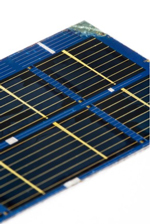
| Home | About Us | Contribute | Bookstore | Advertising | Subscribe for Free NOW! |
| News Archive | Features | Events | Recruitment | Directory |
| FREE subscription |
| Subscribe for free to receive each issue of Semiconductor Today magazine and weekly news brief. |
News
21 September 2009
IMEC GaAs/Ge stacks promise solar cell efficiency hike
A team from the IMEC semiconductor research institute in Leuven, Belgium has found a new way to stack materials that promises to improve the efficiency of multi-junction solar cells.
 Researchers from the institute are presenting details of the method at the European Photovoltaic Solar Energy Conference, which is taking place in Hamburg, Germany this week.
Researchers from the institute are presenting details of the method at the European Photovoltaic Solar Energy Conference, which is taking place in Hamburg, Germany this week.
The first demonstration of the technology is a GaAs/germanium dual-junction cell. In it, the GaAs-based top cell has an efficiency of 23.4%, close to the state-of-the-art figure. The IMEC researchers have taken this cell and transferred it onto a germanium cell.
Normally in multi-junction stacks the top cell is grown epitaxially on the other cells, using a metamorphic approach to reduce defects in the monolithic stack. However, the growth processes needed to achieve this are complicated, with IMEC offering the promise of a simpler manufacturing method.
In IMEC’s first mechanical stack, the germanium bottom cell has a ‘potential’ efficiency of as much as 3.5%, which it says is higher than is typically seen for the bottom cell of a monolithic triple-junction stack.
As a result, IMEC believes that its new mechanical stacking method could deliver triple-junction cells that are 1-2% more efficient than today’s state-of-the-art triple junctions, which typically operate at 35-40% under concentrated sunlight.
Giovanni Flamand, IMEC’s team manager, reckons that the institution will show the first triple-junction cell based on the new stacking method by the start of next year.
As well as offering enhanced efficiencies, Flamand and colleagues say that the new approach will also improve the ‘spectral robustness’ of multi-junction cells, converting a larger part of the solar spectrum into electrical energy.
Dr Jef Poortmans, the director of IMEC’s photovoltaics program , admits that mechanical stacks are more complex to handle and interconnect than monolithic alternatives, but added: “They definitely offer a way to increase the conversion efficiency and energy yield of high-efficiency solar cells. And they also enable an efficient way to try and use new combinations of materials.”
*Another IMEC team has adapted a completely different stacking process, this time using copper metallization, to improve silicon-based solar cells.
Also presented in Hamburg, the large-area cells with copper-plated contacts showed a conversion efficiency of 18.4%. Using copper instead of silver should reduce cell manufacturing costs and make the process more sustainable, said IMEC.
![]() Search: IMEC Multi-junction solar cells GaAs Germanium
Search: IMEC Multi-junction solar cells GaAs Germanium
Visit: www.photovoltaic-conference.com
Visit: www2.imec.be
The author Michael Hatcher is a freelance journalist based in Bristol, UK.